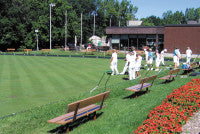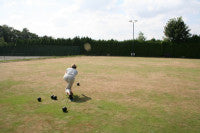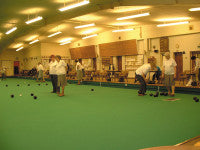Indoor and outdoor surfaces for bowls
 Bowls, both indoor and outdoor, is an activity that can be pursued by people with disabilities as well as able-bodied people. It is an activity that allows these user groups (disabled and able-bodied) to compete amongst themselves or alternatively against each other on equal terms. Therefore, it is important that adequate facilities are provided at bowls and leisure clubs to enable both user groups access to the bowling surface area.
Bowls, both indoor and outdoor, is an activity that can be pursued by people with disabilities as well as able-bodied people. It is an activity that allows these user groups (disabled and able-bodied) to compete amongst themselves or alternatively against each other on equal terms. Therefore, it is important that adequate facilities are provided at bowls and leisure clubs to enable both user groups access to the bowling surface area.
Outdoor lawn bowls is generally played on a fine turf surface, although in some instances alternative vegetation is used, such as Cotula (Leptinella sp) which is used in New Zealand. The outdoor playing season usually commences from the first week in May and ends in the last week of September. Indoor bowls is, however, played on a synthetic textile, known as a "carpet," and is played all year round as it does not have to contend with the variability of the weather that prevents the playing season of outdoor bowls extending into the autumn and winter months.
Indoor and outdoor surfaces should ideally meet certain performance criteria; these have been suggested in several publications as
- The bowling green shall be maintained to achieve a level playing surface that is within ± 6mm of the average height of the green
- The bowling green shall have a green speed of not less than 10 seconds and not greater than 18 seconds, all rinks playing during a competition shall have green speeds within 0.5 seconds of one another
- The bowling green shall have an even draw on both backhand and forehand
Additionally for outdoor lawn bowling greens,
- The bowling green shall have a good cover of fine turfgrass, with a total grass cover of at least 95% of the total bowling green surface, and be free of weeds, pests and diseases
Suitability of fine turf as a surface for lawn bowls
 Bowls, like many sports, has traditionally been played on fine turf; it is only in recent years that synthetic greens have come to the fore as an alternative surface to play on. Fine turf can provide all of the desirable playing characteristics, when maintained correctly. However, as a living organism (the grass plant) great care has to be taken to ensure a successful healthy sward. There are many factors that can influence the quality of a fine turf playing surface, highlighted below are some of the key factors,
Bowls, like many sports, has traditionally been played on fine turf; it is only in recent years that synthetic greens have come to the fore as an alternative surface to play on. Fine turf can provide all of the desirable playing characteristics, when maintained correctly. However, as a living organism (the grass plant) great care has to be taken to ensure a successful healthy sward. There are many factors that can influence the quality of a fine turf playing surface, highlighted below are some of the key factors,
Weather: The lawn bowls playing season is closed during autumn and winter due mainly to prevailing frosts and colder temperatures at that time. Lower temperature reduces the rate at which the grass plant will grow, which means that the surface cannot recover quickly enough from the wear / damage that play causes. Spring and summer months are conducive to good growth, although there are still problems associated with drought and heavy rains that can also affect the quality of the playing surface. Indeed variability in the performance of the green can occur through the playing season due to the weather patterns for example wet conditions from heavy rains will slow the speed of the green
Disease: Disease incidence is usually related to the weather and health of the grass plant, some disease outbreaks can have disastrous effects on playing quality. Typical examples are Microdochium patch (Michrodochium nivale), Dollar spot (Sclerotina homeocarpa) and Take-all patch (Gaeumannomyces graminis)
Pests: Problems can arise from infestations of pests, affecting the sward and playability of the surface, casting worms (such as Lumbricus terrestris) and Leatherjackets (Tipula spp) are prime examples
Weeds:Weed invasion can affect the playability of the surface too, Greater plantain (Plantago major), Daisy (Bellis perennis) and White clover (Trifolium repens) are all common weeds. Grass weeds such as Annual meadow grass (Poa annua) can also affect surface quality.
Maintenance: The most important factor related to the success of the playing surface is the quality and frequency of maintenance. Good groundsmanship is essential, especially at the end of the playing season when renovation work to the green should be carried out. This one factor is directly related to all the other factors and has a very high influence on their occurrence, with the exception of the weather. Therefore fine turf is suitable for bowls as long as the maintenance of the bowling green is to a good standard. However, the maintenance and upkeep of the surface is influenced by the construction of the bowling green in the first instance.
Suitability of a synthetic textile as a surface for indoor bowls
 Indoor synthetic textile surfaces, also known as "carpets" are comparable with first class turf greens in that they can achieve the expected performance criteria (described earlier), assuming that they are laid on a level base. There are many different types of carpet available such as "Needle-punch" and "Woven" synthetic textiles. These carpets should have a minimum life expectancy of ten years, which is important owing to the high costs associated with them, although the life expectancy is dependent on the amount of usage and type of maintenance the carpet receives.
Indoor synthetic textile surfaces, also known as "carpets" are comparable with first class turf greens in that they can achieve the expected performance criteria (described earlier), assuming that they are laid on a level base. There are many different types of carpet available such as "Needle-punch" and "Woven" synthetic textiles. These carpets should have a minimum life expectancy of ten years, which is important owing to the high costs associated with them, although the life expectancy is dependent on the amount of usage and type of maintenance the carpet receives.
As carpet bowls is played along the green only, and not across like lawn bowls, the surface is more prone to wear around the ends and centres of each rink. This requires the carpet panels to be rotated periodically to distribute the wear. When the panels are rotated, they are laid at right angles to the direction of play to prevent the seams interfering with the true roll of the wood. The panels also require re-tensioning several times per year. Additionally the periodical maintenance should include checking the banks / ditches and rink markings, inspecting all seams, examining for underlay problems, all of which should be replaced or repaired as necessary. The speed of the surface should also be assessed.
Routine maintenance should include weekly vacuum cleaning with a "suction only" type vacuum cleaner. Any stains should be treated immediately with a mild detergent or other specific stain treatment. Where any work is carried out above the surface, boards should be laid under any steps, ladders or scaffolding (including portable) and also under the working area in case there are any items dropped onto the surface. If painting work is carried out, the whole area should be protected with polythene with taped joints.
Restrictions and appropriate climate for indoor bowls
Certain restrictions should be imposed on an indoor bowling green carpet to ensure its longevity. Water and other liquids (drinks etc) should be kept off the surface, no smoking should be allowed on the green, nor should any chalking of the surface be allowed. Additionally "Grippos," Polishes" or "Oils" should not be used by the bowlers on the green.
Ideally some heat (7-10°C) should be maintained in the building overnight to avoid condensation which causes watermarks in the carpet. Day temperatures should be between 15-21°C and humidity / moisture levels in the building should be around 15-17%.
Overall the maintenance requirements of a carpet green are lower than those associated with a turf green, but it is still important to carry out routine maintenance to ensure a successful playing surface. Carpet greens are a suitable alternative to turf greens as they can be played on all year round and should maintain consistent playing characteristics.
Accessibility for disabled user groups
There are four officially recognised categories of disability; these are mobility, sight, hearing and learning. In 1995 the government introduced the Disability Discrimination Act (DDA), the provisions of which were further extended with the DDA 2005. Its purpose is to end discrimination against disabled people by giving people with disabilities new rights including access to facilities and services. Amendments to the Building Regulations mean that all new covered buildings including leisure centres have to be accessible. Therefore the playing surface should be located as close as possible to the disabled drivers parking spaces, and to the exit from the building used most by the physically handicapped, adjoining the area some fixed seats should also be provided for the ambulant disabled.
The problems associated with synthetic textiles and fine turf as a playing surface of bowls for these disabled user groups are very similar. Catchment ditches to retain overshot woods, and provide an outlet for drainage pipes in the case of an outdoor green, surrounds both types of surface. These ditches present problems with accessibility for those with a mobility disability, especially wheelchair users. To allow access on to the playing surface a small moveable ramp should be used, enabling wheelchair users to cross the ditch. Some bowling greens have a raised bank surrounding the entire green; this requires access points to be provided through this edge detail.
The playing surface of both construction types can be prone to damage by depression or compaction by wheelchair users, owing to the small size and relatively high ground pressure of the wheelchairs wheels. To prevent this occurring the ends are usually protected by a sheet material or other roll-out carpet that is laid out over the surface and removed when out of use. However, this can mean that wheelchair users have to come off the playing surface and travel around the outside of the green to reach the other end, unless there is room to lay a temporary surface for them to travel on the green from end to end.
 Dr Colin Mumford works for the Landscape and Amenity Management Advisory Service.
Dr Colin Mumford works for the Landscape and Amenity Management Advisory Service.
